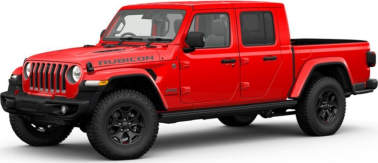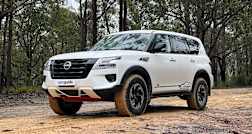A new Jeep stirs up a lot of interest and emotion, good and bad, in those who appreciate a solid off-roader. And a new Jeep ute? Well, that was always bound to kick up a real whirlwind of interest and emotion … good and bad.
And so it is that there’s plenty of excitement and hype surrounding the release of Jeep’s Gladiator, the company’s first ute in a long time. There’s also a ton of pressure on Fiat Chrysler Automobiles to make Jeep's five-seat dual-cab "convertible pick-up truck” succeed as a Ford Raptor rival in Australia.
CarsGuide senior editor Matt Campbell drove a left-hand version in the US and I drove one in New Zealand, but this time was our first chance to drive a right-hand local-spec Gladiator on and off the road in Australia.
On paper, at least, the Gladiator appears to be one of the most capable showroom-standard 4WD utes in Australia.
So, is it seriously a potential threat to the Raptor, or merely a cool-looking but clunky homage to Jeep’s past glories?
Read on.
Jeep Gladiator 2020: Rubicon (4X4)
| Engine Type | V6, 3.6L |
|---|---|
| Fuel Type | Unleaded Petrol |
| Fuel Efficiency | 12.4L/100km (combined) |
| Seating | 5 |
| Price From | $53,900 - $61,930 |
| Safety Rating |
|
Does it represent good value for the price? What features does it come with?
The Gladiator line-up for Australia includes the Overland (MSRP $75,450) and the Rubicon (MSRP $76,450). That’s a chunk of cash but nothing a Jeep fan would flinch at.
As standard the Rubicon variant gets Jeep’s Rock-Trac Active On-Demand II 4x4 system (4:1 transfer case), Tru-Lok front and rear locking differentials, front sway-bar disconnect, Fox 2-inch diameter aluminium-bodied shocks (front and rear), forward-facing TrailCam off-road camera, selectable tyre-fill alert, BFGoodrich Mud Terrain Tyres (255/75 R17), 17-inch alloy wheels, LED headlights/taillights/day-time running lights/fog lights, forward collision warning Plus, adaptive cruise control with stop, blind spot monitor with rear cross path detection, remote proximity keyless entry, nine-speaker Alpine Premium audio system, and Uconnect 8.4-inch multimedia touchscreen with navigation and Apple CarPlay plus Android Auto connectivity.
But our test vehicle came with a stack of extras including the Lifestyle Adventure Group ($3835), which includes cargo management group with trail rail system, lockable rear underseat storage Bin, roll-up tonneau cover, spray-In bedliner, and auxiliary switch bank (four programmable switches), 240-Amp alternator, 700-Amp maintenance-free battery wireless Bluetooth speaker; and the Rubicon Luxury Package ($2535), with black leather trim seats, body-colour fender flares, heated front seats and steering Wheel. It also had a steel front bumper ($1625); Punk'N paint ($1035); and black wheels ($975).
So, total price, including all of the options, for the Gladiator reviewed here is $82,880.
Gladiator paint jobs include Black, Bright White, Billet Silver Metallic, Firecracker Red, Sting Grey, Hydro Blue, Granite Crystal Metallic, as well as two new Gladiator colours: Gobi and Gator. And don’t forget Punk’N – our tester was Punk’N.
The accessories range for the Gladiator is a line-up of more than 70 bits of gear, and includes everything from Jeep windscreen sunshades to a cargo bed storage system (drawers).
Is there anything interesting about its design?
The Gladiator looks very much like its stablemate, the iconic Wrangler. Jeep’s global president Christian Meunier has described the Gladiator as more like "a cousin" than "a brother" to the Wrangler. Whatever that means, the Wrangler influences are there for all to see: chunky front end and blocky body – and now with a stretched tray tail-end.
It has an imposing truck-lite presence at 5591mm long (with a 3488mm-long wheelbase), 1894mm wide, 1909mm high, and with a kerb weight of 2215kg.
Inside, there are metal-plated accents peppered about the cabin, as well as the eye-catching Redical (read: red) instrument panel bezels and red stitching on the leather seats.
Overall, the Gladiator looks cool, managing to get away with a nice blend of retro styling and new-world wow enough to capture the attention of even the most burnt-out and cynical of those among us.
How practical is the space inside?
It’s obvious that people who spend a fair chunk of their time actually in the bush, on the beach and in the desert have designed the Gladiator: the ute has a squared-off and action-ready interior that is well up to the task of copping the dirt and grit of an outdoors life. The cabin feels like it’s water- and weather-proof, even if that may not literally be the case.
It’s a cocoon-like interior and the build quality everywhere you look is very high quality.
The 8.4-inch multimedia touch screen is clear and easy to read while you’re on the go.
The Jeep’s Uconnect system is simple enough to get your head around and Apple CarPlay and Android Auto are easy to get going – hey, if I can do it, anyone can.
There’s also a 7.0-inch information LED display, which depicts, among other details, tyre pressure, tyre-fill alert or digital speed readout.
All controls, dials and switchgear are chunky and substantial, making for very easy operation, no matter how bumpy the terrain is that you’re traversing.
The reach-and-rake-adjustable steering wheel has audio, voice and cruise control controls.
Storage solutions are a bit light-on but they’re all well suited to adventure, such as tensioned mesh pockets on the doors and seat-backs, and small spaces with textured bases for your numerous bits and pieces.
There are two USB ports and a USB-C port up front and two for back-seat passengers.
Seating is decent all-round although anyone taller than Tom Cruise will have to mind their heads on the hard lumpy ceiling.
There’s a shallow storage space under the rear seat and, when that 60/40 split rear seat is folded flat, there are LED lights behind to illuminate the narrow storage space in the rear of the cabin, where there are also storage nets.
What are the key stats for the engine and transmission?
The Gladiator has the Wrangler’s 3.6-litre Pentastar V6 petrol engine (209kW at 6400rpm and 347Nm at 4400rpm) and eight-speed automatic transmission.
That engine has plenty of punch and ample low-end torque and paired with that auto, it’s a real-world-proven combination that’s worked well in the Wrangler and one that’s never often found wanting.
What's it like as a daily driver?
The Gladiator is actually not too bad.
Sure, the steering is Wrangler floaty, with plenty of play in the wheel and understeer through corners, and there’s a fair bit of tyre rumble from the big BFG muddies, and there’s noticeable wind noise generated by the wing mirrors, but otherwise the Gladiator’s not as awkward or even as unrefined as you might expect.
And I reckon it’s a lot of fun to drive because the Gladiator does need a lot of attention and input to keep it on target.
Because it’s basically a stretched Wrangler – with a 787mm longer body and a 492mm longer wheelbase than its stablemate – the Gladiator has a solid stance on the road and, for such an unashamedly off-road-oriented vehicle, it feels even more settled and composed than the Wrangler does on the blacktop.
It’s built to be rugged with a body-on-frame design and reinforced chassis, but the Gladiator is nimble around town, and ride quality is generally impressive with this ute cruising comfortably on live axles front and rear, and coil springs and Fox shocks all-round.
There are, however, some aspects of driving the Gladiator that may annoy some people: visibility is a bit limited in all directions (but if you’ve spent any time in a Wrangler, this won’t even register as a minor issue); the throttle is a bit touchy; the 13.6m turning circle may add a degree of difficulty to your attempts at a fast turnaround (on a city street or in the bush); and all that driver attention and input that I said the Gladiator demands of its steerer will become tiresome for a few drivers.
However, a lot of the Gladiator’s raw appeal and indeed its capability only truly come into play when you head off-road.
What's it like for touring?
Bloody capable, and a whole lot of fun.
The Trail Rated Gladiator is one of the most capable showroom-standard 4WD utes in Australia, and that’s obvious before you even jump into the driver’s seat. Simply by looking at the Gladiator from the outside you can see its off-road readiness – and then dig deeper and its spec sheet is full to the brim with an adventuring armoury rarely seen in an unmodified vehicle.
It’s positively loaded with off-road gear: everything from a second-to-none 4X4 system with 4:1 low-range (contributing to a 77.2:1 crawl ratio), front and rear diff-locks, heavy-duty third-generation Dana 44 axles (front and rear), sway-bar disconnect, and BFGoodrich Mud Terrain tyres, as well as all the fancy new driver-assist tech you could possibly hope for.
Its Fox shocks add a welcome dimension of comfort and handling to the Gladiator on fast dirt and gravel tracks on the way to your chosen off-roading destination.
And it’s really only by driving the Gladiator on rough terrain – very rough terrain – at very low speeds that you gain a true appreciation of its off-road capabilities.
And the best way to do that? Drop the tyre pressures, buckle up and let the Gladiator off the leash.
That 77.2:1 crawl ratio means nothing to most of us until given the opportunity to experience the feeling of all that earth-grabbing torque for yourself. In 4WD low-range first gear, and with both diffs locked, the Gladiator feels unstoppable. I pointed it at short steep hills which made even the onboard off-road pages media-screen app, which displays 'Pitch & Roll’ among other things, tremble in fear. Not really, but those hill-climbs are pretty bloody steep. I’ve been at this spot before and seen the drivers of modified vehicles opt for the ‘chicken’ tracks after having a go at the steepest of these main tracks, which the Gladiator tackled. The only thing is, because of the Gladiator's 3488mm-long wheelbase and 18.4-degree ramp-over angle, there’s a real risk of bellying out or at least giving the undercarriage a bashing when you crest these steep hills, which is why you must drive with more concentrated focus.
But that’s part of that sense of fun I mentioned earlier – related to the Gladiator’s need to be driven with considered attention and input – and that fun carries over into low-range 4WDing. It really is a driver-direct experience: you need to be aware of everything that’s going on, you never feel like you’re one step removed from the situation, or the terrain or the consequences of your driving … you feel dialled into the terrain and that’s guaranteed to put a smile on any fair-dinkum 4WD enthusiast’s face.
Besides, the Gladiator does have substantial underbody skid-plates, protecting the fuel tank, transmission and transfer case, as well as heavy-gauge tubular steel rock rails to soak up any off-road hits.
With an approach angle of 40.7 degrees, a departure angle of 25.1 degrees and a listed running (ground) clearance of 249mm the Gladiator has pretty decent off-road measures.
Suspension travel is rather decent as is, but to get even more stretch from your front end, you can hit the sway-bar disconnect button to drop a wheel to the dirt – or as close as possible depending on how deep the ruts are.
The Gladiator also has Selec-Speed Control (like low-speed 4WDing cruise control, 1-8km/h adjustable), and Off-Road+, which tweaks throttle and traction control, among other systems, to best suit the terrain.
It even has a forward-facing off-road camera so the driver has a chance to see any obstacles that might otherwise not be noticed until it’s too late, such as branches, rocks, tree stumps, rubbish etc. The camera can be washed at the press of a touch-screen button and, yes, we did do that a few times, just for a laugh.
The steel tray's load space is 1442mm wide – 1137mm between the wheel-arches so not wide enough for a pallet – and it is 1531mm long. Load height is 885mm at the tailgate.
The tray has integrated tie-down points and under-rail LED lights.
Payload is a claimed 620kg – pretty ordinary when compared to a lot of dual-cab utes available in Australia – and the Gladiator has a maximum towing capacity of 750kg (unbraked), and 2721kg (braked). Make no mistake, this is not a work truck, this is a weekend-away-camping ute – if you don’t intend to pack much at all.
The spare wheel is a full-size steel one.
Overall, the Gladiator is good fun to drive and very capable, but it’s just not very trip-practical, in terms of being able to carry much gear at all.
How much fuel does it consume?
The Gladiator has a claimed fuel consumption of 12.4L/100km on a combined cycle. The trip computer showed an average of 11.7L/100km after 328.5km, which turned out to be pretty accurate because the actual figure from fill to fill was 11.9L/100km. That figure is low, because even though our drive involved a lot of highway cruising, it also included a few hours of low-range 4WDing. Peculiar.
The Gladiator has an 83-litre tank.
Warranty & Safety Rating
What safety equipment is fitted? What safety rating?
The Gladiator's safety gear includes four airbags, full-speed forward collision warning plus, reversing camera, adaptive cruise control, blind-spot monitoring, rear cross path detection, tyre-pressure monitoring system, and more. It also has hill start assist, hill descent control, and trailer sway control.
It has dual ISOFIX child seat anchor points and three top-tether attachments in the rear seat.
The Gladiator does not yet have an ANCAP safety rating, but its stablemate the Wrangler has a three-star ANCAP rating, revised up from one star in December 2019, so a similar rating for the Gladiator might be on the cards.
What does it cost to own? What warranty is offered?
The Gladiator has Jeep’s five-year factory warranty, five-year capped price scheduled servicing, and lifetime roadside assistance. The first five services are capped at $399 each and scheduled servicing is due every 12 months or 12,000 km, whichever comes first.
Verdict
The Jeep Gladiator Rubicon is, as expected, very impressive off-road, and reasonable on-road, which is a pleasant surprise.
It’s comfortable, looks good and makes for an engaging driving experience, but the Gladiator has quite a narrow focus: it’s not a work truck because it’s hamstrung by a below-par payload, and that payload also inhibits the Gladiator's suitability as a viable off-road tourer. Also, it hasn't yet been ANCAP tested and safety is a crucial factor in any vehicle-buying decision. The Wrangler's three-star ANCAP rating does not bode well.
But none of those things will deter anyone who is enamoured of the Jeep way of life, especially those who love the whole idea of a hard-core Jeep ute.
For a stock-standard vehicle, the Gladiator Rubicon is one of the most capable 4WD utes in Australia and a whole lot of fun to drive.
You have to hand it to Jeep for staying true to its hard-core Trail Rated heritage, but does the Gladiator pose a real threat to the Raptor? Only time will tell.
Pricing Guides








.jpg)



.jpg)



.png)



.png)





.jpg)

